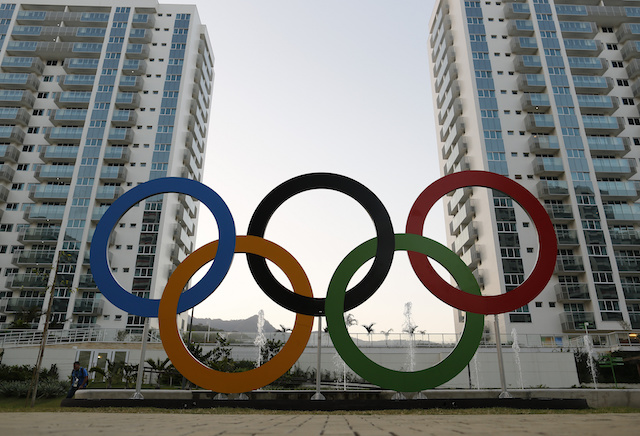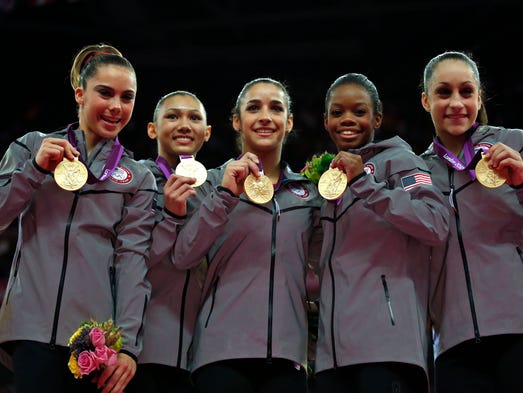American women are stars of the show during Olympics – USA TODAY

Comcast has created new technology that will allow its users to watch the 2016 Summer Olympics in Rio de Janeiro wherever and whenever.
Quick, name a superstar female athlete who doesn’t play tennis or golf.
The odds are good that if you were able to come up with a name at all, she was an Olympian.
That’s because with few exceptions women’s sports are relegated to obscure cable channels (if they are televised at all) and rarely shown in coveted prime-time slots, and thus struggle for sponsors, money and a toehold in America’s sporting consciousness.
Once every four years, however, the Summer Olympic Games give female athletes the platform and exposure they otherwise rarely get. More than 219 million people in the U.S. viewed the 2012 London Games, a record for one event.
For 17 days in Rio de Janeiro, starting with the opening ceremony Friday night, women will be on (almost) equal footing with men. Their stories will be told by NBC, their races will be shown in prime time — Rio is two hours ahead of Central Daylight Time — and their names will appear in newspaper headlines from coast to coast.
“We don’t really care about women’s basketball during the summer when the WNBA is playing,” said Cheryl Cooky, president of the North American Society for the Sociology of Sport, “but we’ll tune in and watch the same women play in the Olympic Games.”
And we will be reminded, once again, how good U.S. women are at running, rowing, swimming and tumbling.
In London, women outnumbered men on the U.S. Olympic team for the first time in history (269-261), and women’s teams won gold medals in basketball, soccer, beach volleyball, rowing, gymnastics and water polo.
In fact, women won 29 of 46 gold medals (63%) and 58 of 103 total medals (56%) for Team USA.
“I was aware of it because that was a huge conversation among scholars and women’s sports advocates, the fact that women were dominating,” said Cooky, an associate professor of American studies at Purdue University. “I don’t think that story got picked up by the mainstream media.
“I think that was a story that could have and should have been a dominant narrative.”
Four years later, the U.S. is sending a 555-athlete team to Rio that again includes more women than men (292-263). No nation has ever brought more women to the Olympic Games.
Team USA includes a women’s basketball team that has won 41 consecutive Olympic tournament games and is pursuing a sixth consecutive gold medal; a women’s soccer team that won gold in London and is the reigning FIFA World Cup champion; a women’s rowing eight team that has not lost an Olympic or world championship title since 2006; and a women’s artistic gymnastics team that has won every world and Olympic title since 2011.
In beach volleyball, Americans have reached the top of the podium at every Olympics since the sport was added in 1996.
In addition, the U.S. team boasts individual stars such as three-time world champion gymnast Simone Biles and teammate Gabby Douglas, the all-around gold medalist in London; swimmer Katie Ledecky, who has never lost in the final of a major international meet; track star Allyson Felix, the winner of four gold medals and six total; Gwen Jorgensen, the world’s dominant female triathlete; and superstar tennis players Serena and Venus Williams.
Boxer Claressa Shields, the reigning Olympic and world middleweight champion, has a 52-1 record and is so intimidating that the trainer of her first-round opponent at the 2014 World Championships threw in the towel to end the fight at the 11-second mark.
The reasons for the Americans’ success across such a wide spectrum of sports are many and varied, but primary among them was Congress’ passage of Title IX in 1972, which prohibited discrimination against girls and women in federally funded education, including in athletics programs.
That opened the floodgates for young women to compete in sports in high schools and colleges and, in turn, become Olympians.
In 1972, only 90 of the 428 athletes who represented the U.S. at the Munich Games were women. By 1996, that number had more than tripled to 277 in Atlanta.
“I give full credit to Title IX, in terms of we’re the only country in the world that connects sports with institutions,” said Donna Lopiano, former CEO of the Women’s Sports Foundation and current president of Sports Management Resources, a consulting group.
Most countries use an early identification system to spot potential athletic talent, but that limits the pool, Lopiano said. Early identification also doesn’t account for athletes who develop and mature at different rates.
“We mass-produce athletes,” said Lopiano, who built a powerhouse program as women’s athletics director at the University of Texas and is recognized as one of the foremost experts on gender equity in sport. “There are so many kids in our funnel; I think that’s probably the primary difference.
“When you think about it, we have probably the largest mass of women in the world playing sports.”
According to the National Sporting Goods Association, women comprised 70.4% of aerobic exercisers, 52.9% of those who exercised with equipment, 52% of volleyball players and 50.7% of swimmers in 2005. And the number of females who worked out with weights increased from 8.3 million in 1990 to 19.4 million in 1999, according to the Sporting Goods Manufacturing Association.
But many American women — and thousands of women across the globe — wouldn’t have a place to showcase their talents, skills and competitive moxie if not for the Olympic Games.
“It’s an honor to be able to go and represent your country,” said Tamika Catchings, making her fourth Olympic appearance with the U.S. women’s basketball team. “Every single time since ’96, when I get my jersey from USA Basketball, I lay it out on my bed and take a picture of it. It’s a reminder of how blessed I am and how much I appreciate the opportunity to represent my country.”
It wasn’t always that way.
The modern Olympic Games were first held in 1896 as a festival for young men to display their athletic prowess. According to Pierre de Coubertin, founder of the International Olympic Committee, “an Olympiad with females would be impractical, uninteresting, unaesthetic and improper.”
Women were included for the first time in 1900, but only in tennis and golf. As the Games grew early in the 20th century, women were added to the program in swimming, diving and fencing.
In 1928, track and field was added for women, but stereotypes about their limited physical capabilities persisted. After a few exhausted women collapsed at the finish line of the 800 meters, the IOC enacted policies that prohibited them from running distances greater than 200 meters at the Olympics until 1960. The women’s marathon was not added until 1984.
Fast forward three decades and women now compete in wrestling (added in 2004), boxing (2012) and rugby sevens (making its debut in Rio).
Have we finally reached a point where those old stereotypes about women’s physical limitations no longer exist?
“I don’t know if I would go that far,” Lopiano said. “I think it does speak to some really important shifts and changes in the kinds of assumptions we make about female physicality. But I think we still have a long way to go until those stereotypes are dead.
“The IOC still has sex-testing policies for women in sport. They don’t for men. Ostensibly, it’s about leveling the playing field but we don’t police men’s bodies in the same way. We’ll test (male) athletes for external factors — steroids and blood doping — but we don’t test them for genetic abnormalities that might enhance their performances. I think that is a good example that speaks to the fact that we still have some work to do.”
Still, the Olympic Games is far and away the world’s biggest stage for female athletes and helps inspire future generations. Millions of impressionable young girls will be watching U.S. women compete fiercely — and win medals — in Rio.
“We see a tremendous increase in the number of young girls who start playing sports after the Olympic Games,” Lopiano said. “There’s no other sports event that treats women this way.”
Added Cooky, “The Olympics show us that women aren’t just on the sidelines, but can be the stars of the show.”
PUBLISHED OLYMPICS: GREATEST AMERICAN MOMENTS






















